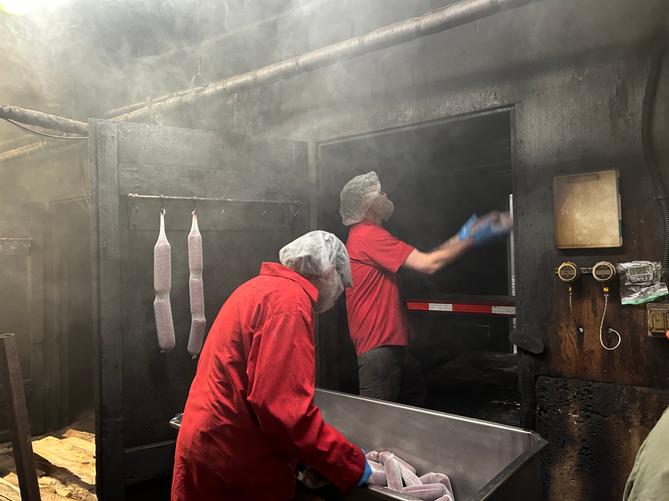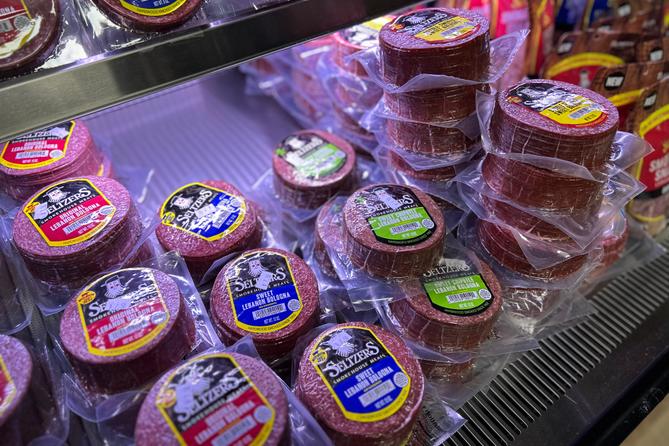Growing up in Lebanon, Pennsylvania, I heard plenty about my home county’s cold-cut claim to fame: Lebanon bologna.
From listening to my grandmother’s stories about her father’s job at a local bologna factory during the Great Depression to slicing Kunzler and Seltzer’s smoked meats for customers at my grocery store deli job the summer after high school, I learned that “Leb-nin buh-LOW-nuh” — that’s the pronunciation I remember hearing — was a point of local pride.
Most accounts trace the smoked deli meat back to the early 19th century, when German immigrants in Lebanon County, aka the Pennsylvania Dutch, created a tangy, beef-forward concoction that doesn’t share much in common with other bolognas of today. Although it’s more often compared to summer sausage, Gastro Obscura writes that it got its name later that century, “a time when actual bologna was the most similar product in size and shape.”
One day, I found myself explaining what Lebanon buh-LOW-nuh is to my partner, who isn’t from Pennsylvania. He looked at me, confused. “Don’t you mean ‘baloney?’” he asked. Then I was the confused one.
“The way I say it must be a Pennsylvania thing,” I thought at the time. But when I recently surveyed some of my Spotlight PA colleagues, who hail from various other parts of the state, on how they pronounce it, every single person said “baloney.”
Feeling thoroughly puzzled, I knew I had to get to the bottom of this. Was my pronunciation a hyperlocal one, or just specific to my family? And why is it different from how everyone else seems to pronounce the word “bologna”?
So I reached out to makers of the delicacy, Lebanon’s local tourism bureau, and an expert in Pennsylvania Dutch culture. I got a clear answer to my first question: Everyone who got back to me confirmed that my pronunciation is indeed local parlance — and it’s pretty unique to the area.
As for my second question, I didn’t really get an answer. While I set out to find a linguistic explanation, I found that the real meat of the issue is cultural. No one could tell me exactly how the local pronunciation came to be, but they pointed to it as something that helps differentiate Lebanon’s homegrown bologna.
Case in point: To Visit Lebanon Valley President Jennifer Kuzo, “baloney” is the Oscar Mayer “pink stuff.”
Lebanon bologna, on the other hand — which is closer to a dark red — is a local product “made with care,” Kuzo told me by email, and carries a different pronunciation because it’s, well, different.
Available in both regular and sweet varieties, Lebanon bologna’s main ingredients include beef, salt, dextrose, sugar, spices, and a lactic acid starter culture that helps lower the pH, contributing to its singular flavor. What Kuzo called the “pink stuff” is made from a blend of chicken, pork, and beef along with water, corn syrup, flavorings, and other ingredients.

Patrick Donmoyer, director of the Pennsylvania German Cultural Heritage Center at Kutztown University, told me he’s been asked about this pronunciation a lot, and the food is “near and dear to my heart as a Pennsylvania Dutch identifying person born in Lebanon.”
“Bologna” isn’t a Pennsylvania Dutch word, Donmoyer explained, but the people adopted it as a “loanword.” Similar to Kuzo, he grew up using the local pronunciation when talking about Lebanon bologna specifically. His family would refer to “smooth-texture pink pork lunch meat as ‘baloney,’” he wrote in an email.
By contrast, his wife has roots in Montgomery County and New Jersey, “and she grew up calling all of it ‘baloney,’” Donmoyer wrote, “which I think is an indication that most Americans use the term ‘baloney’ to refer to lunch meat sausage regardless of its composition, color, or culture of origin.”
Merriam-Webster lists both pronunciations of “bologna” as acceptable, along with “bə-ˈlō-nyə” (said like the Italian city of Bologna). Theories vary as to the linguistic origins of the more popular American pronunciation, but Donmoyer says it dates back centuries, with references to “bolony sausage” appearing in American newspapers as early as the 1830s.
My quest to understand the nuances of the hyperlocal “buh-LOW-nuh” versus “baloney” distinction led me to the Palmyra smokehouses of Seltzer’s, a fourth-generation family-run business that’s been making Lebanon bologna for 123 years and is the largest producer of the lunchmeat today.
Hearing someone say “Lebanon baloney” can make Austin Wagoner, CEO of the company and the great-grandson of its founder, “twitch a little,” he told me jokingly — but he doesn’t usually make a big deal of it.
“It’s one of those flags, like if somebody says ‘Lan-CAST-er’ instead of ‘Lan-kiss-ter,’ right? OK, you’re not from here,” he said. “We may start a Twitter war over it, but we’re not going to correct somebody in person on it unless we’re just having fun with it.”
Employees in Seltzer’s woodsmoke-filled facility handle over 100,000 pounds of beef per week, stuffing casings with the company’s age-old recipe of beef, spices, and more. Workers toss bolognas into the rafters of a wooden smokehouse, where they’re hung and cooked over a fire for about three days. A “smokemaster” tends the fire 24/7, feeding it with hardwood, hickory, and oak.

The result of all this is “a distinct, different product” from “the pink ones,” Wagoner said. “It's all beef, no fillers.”
With how unique the product and process are, the company has “wrestled with” the bologna label “for generations,” Wagoner said, wanting to avoid conflation with other products it viewed as lower quality. Around the late 1990s, the company even experimented with branding a health-conscious version of its product as “beef roll” instead of “bologna.”
“I'm sitting down and looking at it, and I don’t know if it makes a ton of sense to do that,” he said with a laugh. Eventually, “we … lost the beef roll name from it. But it’s not a new issue, is the point of what I’m saying.”
Marketing challenges haven’t gone away. Lebanon bologna has what Wagoner calls a highly specific “regional flavor profile” that hasn’t been adopted on a national scale. It can sometimes feel like Seltzer’s is “swimming against the current a little bit” by making a product that’s so specific to the region, he said. (Around 80% of the company’s sales happen within 150 miles of their Lebanon County smokehouses, according to tour guide Perry Smith.)
Lebanon bologna is also no longer in its heyday, and several producers have shuttered over the decades.
Still, Wagoner finds that when it comes to their county’s best-known creation, many Lebanon locals “hold on to it tightly.” Unusual pronunciation and all, it’s a matter of culture and identity for the area.
“When you go somewhere else and you say what’s unique about me and where I grew up and what I do, this is one of those things,” Wagoner said. “When people want a home care package, this is one of the items that they get because it means home to them … It's an honor to be that for people.”
